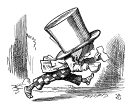Search us!
Search The Word Detective and our family of websites:
This is the easiest way to find a column on a particular word or phrase.
To search for a specific phrase, put it between quotation marks. (note: JavaScript must be turned on in your browser to view results.)
Ask a Question! Puzzled by Posh?
Confounded by Cattycorner?
Baffled by Balderdash?
Flummoxed by Flabbergast?
Perplexed by Pandemonium?
Nonplussed by... Nonplussed?
Annoyed by Alliteration?

Don't be shy!
Send in your question!
Columns from 1995 to 2006 are slowly being added to the above archives. For the moment, they can best be found by using the Search box at the top of this column.
 If you would like to be notified when each monthly update is posted here, sign up for our free email notification list.
If you would like to be notified when each monthly update is posted here, sign up for our free email notification list.
Trivia
All contents herein (except the illustrations, which are in the public domain) are Copyright © 1995-2020 Evan Morris & Kathy Wollard. Reproduction without written permission is prohibited, with the exception that teachers in public schools may duplicate and distribute the material here for classroom use.
Any typos found are yours to keep.
And remember, kids,
Semper Ubi Sub Ubi
|
 readme: readme:
Yow. November already? As Groucho Marx once noted, Time flies like an arrow; fruit flies like a banana.
Fortunately, here at The Word Detective, we like to dwell on the past. As you may know, subscribers to TWD-by-Email (who pony up a measly $15 per year) receive each biweekly batch of columns long before they are published, for free, here on the website. How long? In the case of this November issue, these columns were first seen by subscribers back in February and March of this year. If you notice reader comments on some of these columns, that’s because they’ve been sitting in the special Subscribers’ Content section since last February and March where readers can comment on, add to and sometimes correct what I write. Every month I roll a big batch of columns out of the Subscribers’ section, down the hall and past the coffee machine, into the public area where the whole freeloadin’ world can read them. Everything on this website eventually appears here for anyone to read, absolutely free. That’s important to me, and this is the best way I can think of to keep this site free and still buy food for the cats (and resident people).
The problem, from a non-subscriber’s standpoint, is that some of the most pertinent columns I write (often torn, as the TV shows say, from today’s headlines) remain hidden from the free view until months later, long after “Darn tootin'” (the subject of a recent column) has lost its resonance. The solution, obviously, is for you (yes, you) to quit dawdling and subscribe. You’ll not only receive the columns immediately from now on, but you’ll also be able to read those still parked in the Subscribers’ section right now (i.e., everything written between late March and mid-November). That’s like a 21-month subscription for the price of a one-year sub.
[Note: Fifteen bucks can be a lot of money if you’re retired, disabled, unemployed, or on a restricted income for whatever reason. If you are in such a situation and would like to subscribe but can’t swing it at the moment, please write to me via the question form. You won’t be the only one.]
Onward. Speaking of the past, if you are a subscriber to The New Yorker, you may have missed the fact (I stumbled on it by accident) that the magazine has put its entire archive online, all the way back to the first issue from 1925. This is a good thing for me, as it obviates the need to maintain a Windows (eewww…) partition on my computer in order to use The Complete New Yorker on DVD, a creation that, for all its wonders, may be the single worst piece of software ever written in terms of usability. OK, I exaggerate, but not by much. Just the need to keep switching among the eight DVDs to read articles is a major disincentive to actually using the thing.
[more grumbling after the jump]
Continue reading this post » » »
Next stop, Moody Blue hair.
Dear Word Detective: I was listening to a Huey Lewis and the News song “Hip to be Square” and that got me to wondering where the word “square,” meaning nerdy or not with it, comes from. What say ye, oh Emperor of Etymology? — Harry.
Huey Lewis? Oh my. You should be careful with that sort of thing, you know? One minute you’re innocently listening to your car radio in traffic, reliving the carefree 1980s, “Back to the Future” and all that. But the next thing you know you’re waving your Bic at one of those Geezer Rock Reunion concerts public TV runs during pledge drives. Then you start ordering all your old James Taylor LPs on CD. Then you move to some development called “Silver Waves” in Florida where you drive your golf cart to dinner at 4:30. But it’s never too late to rage, rage, against the pastel horror. Personally, I recommend homebrew absinthe and lots of really loud zydeco.
Just kidding, of course. I’m more the black coffee and Bach type (which might strike some people as “square,” but those people probably drink Folgers and simply don’t get Bach). “Square” is, of course, a highly subjective label, and even the generally-accepted terms for the opposite of “square” have their own constantly-changing fashions (“hip”? “cool”? “hot”?). You know you’re dancing on the razor’s edge of high culture when saying “hip” makes you “square.”
Some fields of human endeavor are, however, apparently exempt from this Manichaean “cool” vs. “square” debate and are considered permanently “cool.” One of these blessed realms is jazz, so it’s appropriate that “square” meaning “boring, conventional, conservative, out of touch” began as slang among jazz musicians in the late 1920s. The criterion at the time for seeming “square” to jazz musicians was, not surprisingly, simply not properly appreciating jazz. But by the end of World War II, “square” had spread into teen slang and broadened in meaning to include anything and anyone that bored American teenagers.
In adopting the term “square” to their own use, the jazz musicians were, ironically, simply employing a very old sense of “square” meaning “fair, honest, reliable or in proper order” (still heard in phrases such as “square deal”). This “square,” which dates back to at least the 16th century, rests in turn on the use of “square” to mean “equal” (as are the sides of a geometric square) or “solid, steady” (as a structure with properly square joints). The use of “square” in “square meal” conveys the same sense of “proper and substantial” (and, despite the popular legend, has nothing to do with square plates). As slang for the conservative types of music jazz marked a radical departure from, “square” was a perfect fit.
BTW, Windows 95 is alive and well around here.
Dear Word Detective: We were talking words with our friends and came up with two puzzlers. “Stogie” — is it related to Conestoga, and, if so, how? The other is “slue (slew) foot.” I feel it has a bit of a negative connotation, but I’d like your take on both these. — Charlie.
It must be nice to live where people talk about words. Our neighbors, having determined years ago that I apparently just don’t care about sports, hunting, home renovation or the mating habits of all the other neighbors, now simply nod and smile when we meet in the Post Office. But they do call me when their computers malfunction, so I guess I belong here after all.
Your hunch about “stogie” (or “stogy”) being related to Conestoga is right on the mark. Conestoga is the name of a township in central Pennsylvania, taken from the name of a local Indian tribe, and the Conestoga wagon, originally built in that region and also called a “covered wagon,” was widely used for westward migration in the 18th and 19th centuries. If you’ve ever seen a wagon train crossing the prairie in a Hollywood western, you’ve seen replicas of Conestoga wagons.
A large wagon capable of carrying several tons of cargo, the Conestoga was also the mainstay of commercial transport across the Appalachians until the advent of the railroads, and “stoga” drivers were the truckers of their day. Along with “Conestoga” becoming a colloquial term for the large breed of horse used to pull the wagons, “stoga” came, by the late 19th century, to mean the kind of heavy boots worn by the drivers. By the early 20th century, “stogy” was being used for the long, thin cigars apparently favored by the “stoga” drivers. Today, however, we use “stogy” to mean any sort of inexpensive cigar.
A person who is “slew-footed” walks with their feet turned outward. The source of the word “slew” is, unfortunately, a complete mystery. We do know that “slew” first appeared in English as a nautical term in the 18th century, in the spelling “slue” (which is still common), meaning “to swing an object around on its axis without shifting its position,” as a cannon might be “slewed” to track a target. Over the years, “slew” has also become slang, primarily in Australia and New Zealand, for becoming disoriented in the wilderness (“We separated, followin’ tracks, and I managed to get slewed,” 1929) as well as for “to trick or deceive.” “Slewed” has also been, since the 18th century, slang for “drunk.”
Since a “slewfoot” posture is generally considered a bit unstable, “slewfoot” carries the secondary connotation of “a clumsy person,” usually with overtones of slow-wittedness and fecklessness (“She is hoping that her galloping, slue-foot, light-brown, lazy husband … will soon find a job,” 1945).
|
Makes a great gift! Click cover for more.  
400+ pages of science questions answered and explained for kids -- and adults!
FROM ALTOIDS TO ZIMA, by Evan Morris
 
|
 readme:
readme:

 can be found
can be found 




Recent Comments